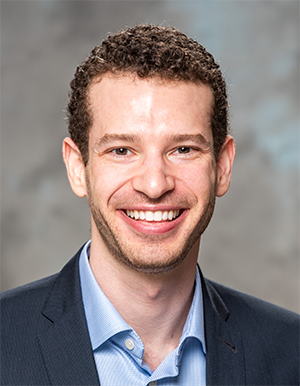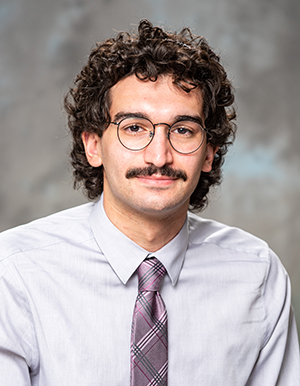Reinforcement Learning Approach in Electronic Design Automation Earns Top Honors at DAC 2023
Aug 31, 2023 —

The team receiving the Design Automation Conference (DAC) Best Paper Award For Research in July. Left to right: Sung Kyu Lim, Wei-Ting Chan, Yi-Chen Lu, and Deyuan Guo (not pictured: Vishal Khandelwal, and Sudipto Kundu).
Researchers from the Georgia Tech Computer-Aided Design (GTCAD) Laboratory in the School of Electrical and Computer Engineering have received this year’s Design Automation Conference (DAC) Best Paper Award For Research.
The award-winning paper was co-authored by Motorola Solutions Foundation Professor Sung Kyu Lim and Yi-Chen Lu (ECE Ph.D. ’23, currently at Apple), in collaboration with a team from Synopsys, Inc comprised of Wei-Ting Chan, Deyuan Guo, Vishal Khandelwal, and Sudipto Kundu.
The research, titled “RL-CCD: Concurrent Clock and Data Optimization using Attention-Based Self-Supervised Reinforcement Learning,” received Best Paper recognition out of 1,157 submissions. It presents a Reinforcement Learning (RL) agent in Concurrent Clock and Data (CCD) optimization — a technique used in modern computer design tools to improve the performance and reliability of digital circuits. The introduction of an RL agent enables systems to intelligently enhance their ability to correctly rank violating endpoints according to machine learning-based optimization strategies. This contributes to an optimization flow that maximizes the overall efficiency and effectiveness of the system's performance.
The team was presented the award at DAC 2023 — the flagship conference in electronic design automation (EDA) — in San Francisco this July.
Last year, Lim and his research team were presented with the Donald O. Pederson Best Paper Award for their research on Compact-2D physical design tools at DAC. The work was recognized as the best paper published in IEEE’s Transactions on Computer-Aided Design of Integrated Circuits and Systems (IEEE TCAD), the flagship journal of the IEEE Council on Electronic Design Automation (CEDA).
Top photo caption: The team receiving the Best Paper Award For Research this July at the Design Automation Conference. Left to right: Sung Kyu Lim, Wei-Ting Chan, Yi-Chen Lu, and Deyuan Guo (not pictured: Vishal Khandelwal, and Sudipto Kundu).
Dan Watson
28th NanoFANS Forum
Bio-microfluidics is an interdisciplinary field of research that combines microfluidics with the science of living systems, having applications ranging from medical diagnostics to targeted drug delivery. It is an emerging field of research aiding in the development of inexpensive, portable, disease detection systems / diagnostic platforms. Bio-microfluidics primarily rests on the pillars of cellular and molecular biology and microscale fluid mechanics.
New Process 3D Prints Glass Microstructures at Low Temperature with Fast Curing
Oct 04, 2023 —

A “GT” logo glass at only 120 x 80 micrometers. The structures was 3D printed using a process developed in Jerry Qi's lab that allows creation of transparent tiny structures at low temperatures.
Using ultraviolet light instead of extremely high temperatures, a team of Georgia Tech researchers has developed a new approach for 3D printing small glass lenses and other structures that would be useful for medical devices and research applications.
Their process reduces the heat required to convert printed polymer resin to silica glass from 1,100 degrees Celsius to around 220 degrees C and shortens the curing time from half a day or more to just five hours. They’ve used it to produce all kinds of glass microstructures, including tiny lenses approximately the width of a human hair that could be used for medical imaging inside the body.
Led by George W. Woodruff School of Mechanical Engineering Professor H. Jerry Qi, the team described their approach Oct. 4 in the journal Science Advances.
“This is one of the exploratory examples showing that it is possible to fabricate ceramics at mild conditions, because silica is a kind of ceramic,” Qi said. “It is a very challenging problem. We have a team that includes people from chemistry and materials science engaged in a data-driven approach to push the boundary and see if we can produce more ceramics with this approach.”
Joshua Stewart
College of Engineering
$50M Cancer Moonshot Grant Will Build an Atlas for Earlier Cancer Detection
Sep 29, 2023 —

The Georgia Institute of Technology will lead development of a new generation of cancer tests capable of detecting multiple types of tumors earlier than ever with up to $50 million from President Joe Biden’s Cancer Moonshot initiative.
Led by biomedical engineer Gabe Kwong, the project will map the unique cellular profiles of cancer cells and leverage that knowledge to build new bioengineered sensors to detect those profiles. The goal is to create a new kind of multi-cancer early detection test that would allow oncologists to start treating the tumors sooner, when they’re still small and most responsive.
The funding announced Sept. 26 is from the new Advanced Research Projects Agency for Health (ARPA-H) and part of the Biden administration’s efforts to cut the cancer death rate in half in 25 years.
Joshua Stewart
College of Engineering
Georgia Tech Researchers Provide Insight into Evolving Drug-Delivery Systems Technology
Sep 29, 2023 —

Alex Abramson, assistant professor in the School of Chemical and Biomolecular Engineering
Imagine having a tiny device inside your body that can continuously monitor your health and deliver the right treatment when needed. That's what closed-loop drug delivery systems (CLDDs) can provide, automatically monitoring, adjusting, and administering medication in response to specific signals within the body.
For example, CLDDs can be used to manage chronic medical conditions, such as diabetes, where maintaining precise control over mediation dosage is critical.
While they hold immense promise for improving patient outcomes and treatment adherence, CLDDs have only recently entered clinical use due to the difficulty in integrating the sensing and actuating components of human-machine Interfaces (HMIs).
Researchers at Georgia Tech’s School of Chemical and Biomolecular Engineering have published an article in Device that provides a comprehensive overview of advancements, strengths, and challenges associated with various CLDD approaches.
Examples of devices already in use include insulin pumps, implantable pain pumps, and epilepsy neurostimulators.
In the paper, titled “Communication Protocols Integrating Wearables, Ingestibles, and Implantables for Closed-Loop Therapies,” the researchers explore both passive and active CLDDs.
Passive devices (typically implantable or ingestible) can release drugs over extended periods without active, real-time monitoring, while active CLDDs incorporate real-time monitoring and feedback mechanisms to adjust drug delivery in response to changing circumstances.
“Active closed-loop, drug-delivery systems are poised to usher in a new generation of remote, personalized healthcare driven by human-machine interfaces,” said study co-author Alex Abramson, an assistant professor in Georgia Tech’s School of Chemical and Biomolecular Engineering.
“But to accentuate the shift from passive to active CLDDs, the integration of advanced sensors and actuators is crucial,” added Ramy Ghanim, a PhD student in Abramson’s lab and co-author of the paper.
Sensors in CLDDs continuously monitor specific health parameters in the body (e.g., blood glucose levels for diabetics), and that data is fed to actuators that determine if a specific treatment is needed (such as releasing insulin).
Communication Systems
In the article, the researchers explore various methods for communication transmission in CLDDs, including hardwiring, radio frequency (RF) wireless communication such as Bluetooth, ultrasound, and in-body communication (harnessing the body itself for data transfer through methods like ionic, biochemical, and optical communication). Each method comes with unique advantages and challenges, according to the researchers.
Challenges in developing advanced HMIs include battery size constraints, powering requirements, data transmission rates, and locational dependance.
One big challenge is making sure these devices work no matter where they are inside a patient. Like a cellphone working best near a Wi-Fi router, these devices need to be in the right place to communicate effectively. Sometimes, they move around inside the body, which can be a problem.
The paper explores potential solutions to various challenges, including energy harvesting techniques, wireless powering, and location tracking systems. Ensuring secure data transmission and protection against hacking is also crucial, the researchers noted.
Benefits to Patients
Benefits of CLDDs include simplicity by automating treatment, reducing side effects by delivering medication precisely in a timely manner, and cost-effectiveness by reducing hospitalizations and complications associated with patient non-compliance.
Up to half of all patients requiring frequent and redundant dosages are noncompliant, sometimes missing doses due to complex treatment regimens, according to the researchers. Consequences include decreased quality of life, preventable disease progression, and an estimated annual cost of $528.4 billion in U.S. healthcare expenditure solely due to suboptimal medication therapy.
“Closed-loop drug delivery systems are poised to transform the landscape of chronic illness treatment by enhancing therapeutic release profiles and easing drug administration, thereby improving patients’ quality of life, decreasing medical expenditures, and improving compliance,” Abramson said.
CITATION: Ramy Ghanim, Anika Kaushik, Jihoon Park, and Alex Abramson, “Communication Protocols Integrating Wearables, Ingestibles, and Implantables for Closed-Loop Therapies,” Device, https://www.cell.com/device/fulltext/S2666-9986(23)00144-8, 2023

Ramy Ghanim, PhD student in the School of Chemical and Biomolecular Engineering

Brad Dixon, braddixon@gatech.edu
Computing Faculty Supporting Research That Could Cut Cancer Deaths in Half
Sep 26, 2023 —

A surgically implantable device the size of a pinky finger could be a huge step toward a cure for cancer. A multi-institutional team of researchers that includes Georgia Tech faculty received $45 million from the Advanced Research Projects Agency for Health (ARPA-H) to develop sense-and-respond implant technology for cancer treatment.
The National Cancer Institute estimates more than 600,000 people will die of cancer in the U.S. in 2023, but the researchers say their project could reduce the number of U.S. cancer-related deaths by 50%.
Josiah Hester, an associate professor in Georgia Tech’s School of Interactive Computing, is a co-principal investigator on the project and is responsible for the sensing and computing technology in the implantable device. He will also assist with large-scale experimentations and coordinate the integration of the technology.
Hester specializes in developing sensing, battery-free, and sustainable technology for wearable and mobile devices. He previously worked on a team that developed the first battery-free handheld gaming console.
Celine Lin, associate professor in Georgia Tech’s School of Computer Science, is working with Hester to develop ultra-energy-efficient chips for signal processing and embedded control. Together, they will develop a robust platform that is energy-efficient enough to last for months.
The device contains genetically engineered cells catered to each individual patient that attack and eliminate cancer cells in the body. Thanks to Hester’s efforts, the device can monitor a patient’s cancer and adjust the dosage of the genetically engineered cells in real time.
“We must keep the cells alive to fight the cancer, and we must understand and control our progress in delivering this treatment,” Hester said. “Releasing too many cells could be toxic, and not releasing enough could be ineffective.”
Omid Veiseh, a bioengineer at Rice University, serves as principal investigator on the project and genetically engineers the cancer-attacking cells.
Along with Hester and Lin, Veiseh’s team consists of 19 co-PIs from the University of Texas, Stanford University, Carnegie Mellon University, Northwestern University, the University of Houston, and Johns Hopkins University.
The researchers named their project Targeted Hybrid Oncotherapeutic Regulation (THOR) and named the implantable device Hybrid Advanced Molecular Manufacturing Regulator (HAMMR).
Over the next five years, the team will test this unique approach to cancer treatment on patients with ovarian, pancreatic, and other difficult-to-treat cancers. They expect to not only improve immunotherapy outcomes for patients, but to make treatment more accessible.
Hester said once the device is surgically implanted, it is designed to remain in the body for six months or more, making it a minimally invasive alternative to chemotherapy.
“If you’re a patient with advanced stage cancer, you might be going in weekly to do various invasive and painful procedures,” Hester said. “This implant could remove a lot of the burden and make cancer treatment more accessible.
“Instead of driving three or four hours to get your treatment — which is expensive, and you may not be able to do it — you can have this implant. You come for the surgery, then you leave, and it stays with you for six months. The localized treatment should reduce the pain and terrible symptoms that chemotherapy and other systemic treatments cause in current protocols.”
ARPA-H is a federal funding agency established in 2022 to support research that has “the potential to transform entire areas of medicine and health.” THOR is the second program to receive funding from ARPA-H after its first Open Broad Agency Announcement solicitation for research proposals.
The first funding contract went to a team of researchers led by Philip Santangelo, a professor in the Wallace H. Coulter Department of Biomedical Engineering at Georgia Tech and Emory. Their project, known as CUREIT, uses mRNA drugs to activate or switch off certain genes to help the immune system fight cancer and other chronic diseases.
Nathan Deen, Communications Officer
School of Interactive Computing
GEDC Distinguished Lecture | Conformal Metasurfaces For Exotic Designer Wavefronts
Host: Joshua Kovitz
Co-host: Nima Ghalichechian
Lauren Garten Receives Future of Semiconductors Award
Sep 21, 2023 —

The U.S. National Science Foundation today announced 24 research and education projects with a total investment of $45.6 million — including funding from the "CHIPS and Science Act of 2022" — to enable rapid progress in new semiconductor technologies and manufacturing as well as workforce development. The projects are supported by the NSF Future of Semiconductors (FuSe) program through a public-private partnership spanning NSF and four companies: Ericsson, IBM, Intel and Samsung.
"Our investment will help train the next generation of talent necessary to fill key openings in the semiconductor industry and grow our economy from the middle out and bottom up," said NSF Director Sethuraman Panchanathan. "By supporting novel, transdisciplinary research, we will enable breakthroughs in semiconductors and microelectronics and address the national need for a reliable, secure supply of innovative semiconductor technologies, systems and professionals."
NNCI Societal and Ethical Implications Webinar | Ethically Responsible Conduct of Scientists and Engineers at Theranos
Abstract: The Theranos episode has been discussed in detail by journalists, government officials, judges and juries for the past several years. While the primary focus of these explorations has been on various alleged legal transgressions of top management, a 2022 article on the Theranos case brought to light stories of a number of scientists and engineers whose conduct was admirable and animated by serving the public interest.
Isotyping: The Key to Unlocking a Long Tail of Hardware Devices
Abstract: As digital technologies continue to expand and evolve, we rely on a greater number and variety of devices at home and in the workplace. Fortunately, the process of developing new hardware devices to the point of a working prototype has become democratized; a wide variety of platforms, development tools and online resources support hobbyists and professionals alike. This has unlocked a ‘long tail’ of prototype devices from wearable and environmental sensors to novel smart displays, home appliances and beyond.
